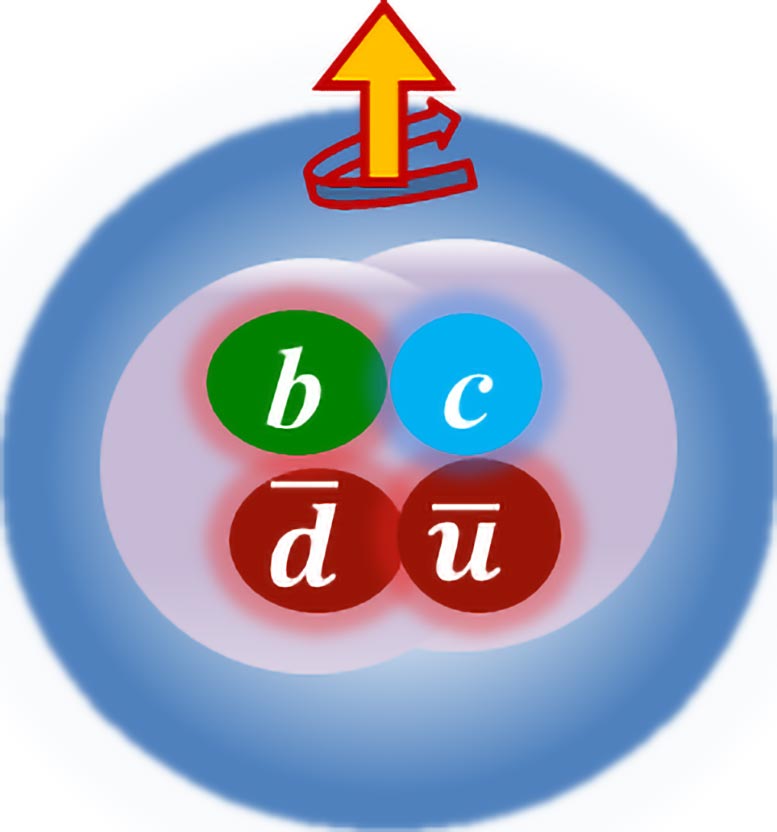
From The Tata Institute of Fundamental Research [ टाटा मूलभूत अनुसंधान संस्थान] (IN)
Via
5.20.24

Researchers have recently revealed new insights into exotic subatomic particles and the strong force. Their work predicts the existence of a novel tetraquark, composed of beauty and charm quarks along with two light anti-quarks, using computational methods. This discovery enhances our understanding of Quantum Chromodynamics and the composition of visible matter. Credit: SciTechDaily.com
A new study unveils the existence of a tetraquark composed of beauty and charm quarks, advancing our knowledge of subatomic particle physics and strong force interactions.
Exploring the complex domain of subatomic particles, researchers at The Institute of Mathematical Science (IMSc) and the Tata Institute of Fundamental Research (TIFR) have recently published a novel finding in the journal Physical Review Letters. Their study illuminates a new horizon within Quantum Chromodynamics (QCD), shedding light on exotic subatomic particles and pushing the boundaries of our understanding of the strong force.

Schematic picture of the predicted Tetraquark, Tbc, made of four quarks: beauty, charm quarks and two light anti-quarks. Credit: Nilmani Mathur
The Enigmatic Strong Force and the World of Hadrons
At the core of this exploration lies the enigmatic fundamental strong force, which generates almost all mass of all visible matter in the universe. A handful of fundamental particles, known as quarks, engaging in intriguing interactions by exchanging gluons, create all composite subatomic particles that eventually form all the visible matter of our universe.
Central to this understanding is the theory of Quantum Chromodynamics (QCD), which governs the dynamics of strong interactions. QCD allows the formation of color-neutral combinations of quarks into subatomic particles generically referred to as hadrons.
Traditionally, hadrons have been classified into two main categories: mesons, such as pions, consisting of one quark and one antiquark, and baryons, like protons, composed of three quarks. However, beyond these categories lie exotic hadrons, including those with four, five, or six quarks, and even particle with gluons, such as glueballs.
Until relatively recently, however, the existence of these exotic hadrons remained largely uncharted territory for particle physicists. Over the past decade and a half, a flurry of experimental discoveries has illuminated this previously obscure domain, unveiling a rich spectra of exotic hadrons that defy conventional notions of the strong force and challenging our understanding of subatomic particles.
A Novel Beautiful-Charming Tetraquark
Schematic view showing the formation of Tbc through interactions of a bottom and a charm mesons. Credit: A. Radhakrishnan and V. Raj
Discovering Tetraquarks: A New Frontier in Particle Physics
Among these exotic hadrons are tetraquarks, which are composed of four quarks (more precisely, two quarks and two anti-quarks). They could exist in highly compact forms or as loosely bound molecules of two mesons or something else: the precise structures of them remain a mystery. They are also observed to the most common exotics and it is expected that many more will be discovered in the future. Theoretical studies can aid in discovering those by predicting their quark contents and possible energy ranges.
In this recent work, Prof. Nilmani Mathur and a postdoctoral fellow, Dr. Archana Radhakrishnan, from the Department of Theoretical Physics, TIFR, and Dr. M. Padmanath from IMSc have predicted the existence of a novel tetraquark. This new subatomic particle is composed of a beauty and a charm quarks along with two light anti-quarks, and it belongs to a family of tetraquarks, called Tbc: the beautiful-charming tetraquarks.
They have utilized the computational facility of the Indian Lattice Gauge Theory Initiative (ILGTI) to carry out this calculation. The formation of this particular tetraquark was investigated using the interactions between a bottom and a charm mesons. Utilizing variational techniques across varied lattice spacings and valence light quark masses, this study investigated energy eigenvalues of the interacting meson systems within finite volumes, and arrived at the conclusion on the existence of this tetraquark. Similar to the predicted particle there could be other tetraquarks with the same quark content but with different spin and parity.
This prediction arrives at a fortuitous moment, coinciding with the recent discovery of a tetraquark (Tcc) containing two charm quarks and two light antiquarks. Consequently, there exists a distinct possibility that the newly predicted particle or a related variant could well be discovered using similar experimental methodologies, given that the energy range and luminosity required for their production and detection are becoming increasingly accessible.
Furthermore, the binding energy of the predicted particle exceeds that of any discovered tetraquarks and the binding weakens as the mass of the light quark increases, alluding to intricate dynamics of strong interactions across diverse quark mass regimes as well as elucidating the intriguing features of strong force in hadron formation particularly those with heavy quarks.
This also brings additional motivation to search for heavier exotic subatomic particles in next-generation experiments, which could be utilized in deciphering the strong force and unlocking its full potential.
See the full article here.
Comments are invited and will be appreciated, especially if the reader finds any errors which I can correct.
five-ways-keep-your-child-safe-school-shootings
Please help promote STEM in your local schools.

The Tata Institute of Fundamental Research [टाटा मूलभूत अनुसंधान संस्थान] (IN)
TIFR is a National Centre of the Government of India, under the umbrella of the Department of Atomic Energy, as well as a deemed University awarding degrees for master’s and doctoral programs. The Institute was founded in 1945 with support from the Sir Dorabji Tata Trust under the vision of Dr. Homi Bhabha. At TIFR, we carry out basic research in physics, chemistry, biology, mathematics, computer science and science education. Our main campus is located in Mumbai, with centres at Pune, Bengaluru and Hyderabad.

